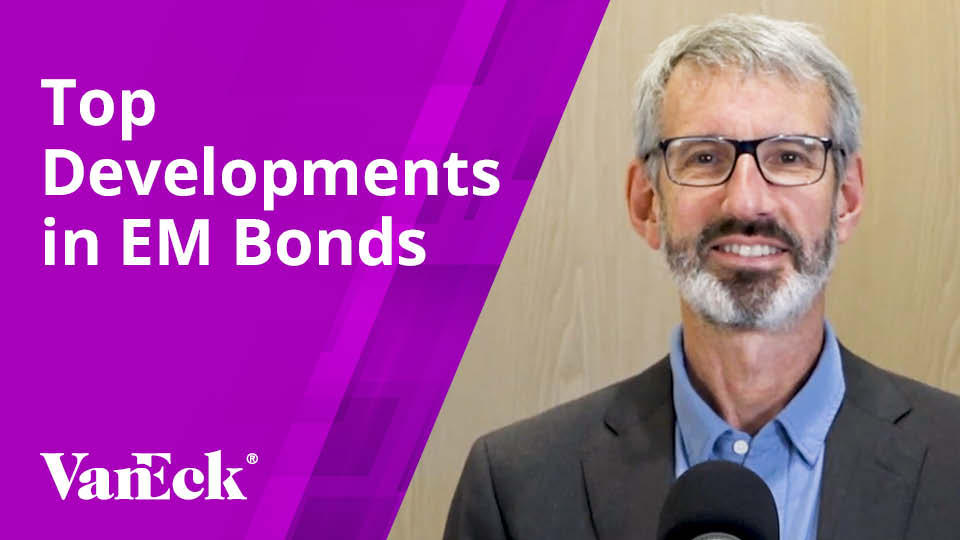2024 Investment Outlook Q&A: Rates, Landing and Where to Invest
December 19, 2023
Read Time 10+ MIN
Looking at the world through a longer-term lens, CEO Jan van Eck recently broke down the secular trends shaping the next wave of exponential growth potential. Standing on the precipice of 2024, Jan explored where we think investors—several years from now—may wish they had invested today. In this more granular discussion, portfolio managers from across VanEck come together to share insights on what to expect in their respective asset classes and highlight areas of the market that investors should consider allocating to now.
- What key factors will shape your asset class forecast through the end of the year and for 2024?
- What do you view as the biggest risks and opportunities in your asset class in 2024?
- Why should investors be considering your asset class in 2024?
What key factors will shape your asset class forecast through the end of the year and for 2024?
Asset Allocation Outlook
DAVID SCHASSLER, HEAD OF MULTI-ASSET SOLUTIONS: We have an inflation playbook that was developed by studying history. It separates inflationary regimes into two distinct periods.
The first half:
- Extreme money supply expansion leads to inflation.
- Inflation sends assets with scarcity, such as real assets, higher.
- The government responds by increasing interest rates.
The second half:
- Higher interest rates and inflationary cost pressures weigh heavily on the economy and traditional assets.
- Investors seek protection in gold and other real assets.
- Inflation gradually declines, with periods of deceleration and reacceleration, while staying elevated, on average, for an extended period.
We’re now in the second half. As such, we are very bullish on gold and other real assets.
Fixed Income Investing Outlook
FRAN RODILOSSO, HEAD OF FIXED INCOME ETF PORTFOLIO MANAGEMENT: Most market participants are laser focused on Federal Reserve (Fed) policy and the prospect of rate cuts for next year. However, we are more focused on marginal drivers of growth, inflation, and global economic and political stability. More specifically, we believe markets will be driven by larger shifts in the U.S. growth outlook as the 2024 election cycle evolves. We also believe that a victory by either party (or any combination of executive and legislative wins) will not lead to meaningful fiscal tightening. Longer term, the U.S. fiscal situation is negative for Treasury bonds, and we believe will receive increasing attention from bond investors in 2024.
Meanwhile, China’s growth outlook is even more critical to many of the resource driven economies in our emerging markets (EM) portfolios. The manner and extent to which China's economy manages to rebound from the property sector's critical downturn will have repercussions beyond its borders, potentially reshaping the global economic landscape and carrying significant geopolitical consequences. As we move into 2024, leaving behind a year marked by dual conflicts and strained international relations among major world powers, geopolitics emerges as a crucial factor influencing the future.
Emerging Markets Debt Outlook
ERIC FINE, PORTFOLIO MANAGER, HEAD OF ACTIVE EM DEBT: The impact of a potential U.S. recession on emerging markets bonds will be a defining factor in 2024. If the U.S. experiences a mild downturn—a “soft-landing” where inflation eases and leads to lower policy and market interest rates—EM bonds are likely to benefit in two ways. Firstly, lower interest rates in the U.S. generally boost all bond values. Secondly, a reduction in U.S. policy rates could diminish the U.S. dollar's strength internationally, potentially allowing EM currencies to strengthen. Such currency strength may further drive down EM local interest rates, creating a self-reinforcing cycle. Conversely, should we encounter a “stagflation” scenario, where economic stagnation combines with inflation, EM bonds could still come out ahead. Many EM bonds, particularly those outside of Asia, are tied to economies that are major commodity exporters. These would profit from sustained high export revenues coupled with stable, elevated interest rates.
Municipal Bonds Outlook
JIM COLBY, PORTFOLIO MANAGER AND STRATEGIST, MUNICIPAL BONDS: The Fed's monetary policy and interest rate decisions will have the most profound influence on municipal bond performance in 2024. The key factor will be the Federal Reserve's interpretation of economic indicators. If the Fed concludes that its policies have effectively curbed inflationary pressures, leading to improved bond performance, we may see a positive impact. Conversely, if inflation remains stubbornly high, the Fed may opt to maintain elevated interest rates, which could inhibit a market rally.
Digital Assets & Crypto Outlook
MATTHEW SIGEL, HEAD OF DIGITAL ASSETS RESEARCH: In assessing the outlook for Bitcoin and digital assets adoption in 2024, we identify several key tailwinds:
- Fiscal scrutiny during the election year: The G7's fiscal challenges will come to the fore as these nations confront the need to refinance approximately $2.1T in sovereign debt, amidst widespread critique over the use of these funds. With a trend of foreign central banks divesting from U.S. Treasuries in favor of gold, we anticipate a renewed narrative that positions Bitcoin as a refuge against expansive monetary policies.
- Introduction of Spot Bitcoin ETFs: The anticipated release of spot Bitcoin ETFs is expected to generate significant investment from regulated institutions, building on the momentum from global Bitcoin ETNs, which have already seen substantial inflows. We believe the U.S. spot Bitcoin ETF, offering enhanced governance and custody, could unlock over $2B in new investments in the first quarter alone.
- Policy endorsement in Argentina: With the libertarian Javier Milei at the helm, who has signaled support for Bitcoin's integration into the financial system, we may see state-backed initiatives, including Bitcoin mining.
- Supply dynamics from “the halving”: Bitcoin's scheduled algorithm change in April 2024 will halve the rate at which new coins are produced, potentially increasing production costs and, historically, driving up prices, provided demand remains constant.
- Political influence: The ascent of presidential candidates favoring digital assets could significantly alter the regulatory outlook. For example, Donald Trump reported $5M+ in Ethereum holdings on his campaign’s most recent financial disclosure.
- Coinbase vs. SEC litigation outcome: Should Coinbase emerge victorious against SEC allegations of selling unregistered securities, it could precipitate a leadership change within the agency, given its series of legal setbacks.
- Energy narrative shift: As the “Net Zero” initiative faces legal and political pushback, public opinion may shift towards a greater acceptance of energy consumption. This could be a positive for Bitcoin, which has faced misinformation regarding its energy intensity (which we see as a feature rather than a bug).
Gold Outlook
IMARU CASANOVA, PORTFOLIO MANAGER, GOLD AND PRECIOUS METALS: Gold prices should continue to have a meaningful impact on our outlook for the miners through the end of this year and into next. With respect to gold, specifically, we view the following factors as most relevant for now:
- Demand: Central bank net purchases of gold have been strong this year and may even exceed record levels reported in 2022. In contrast, investment demand—historically, the main driver behind a gold price rally—has been declining. In our view, any type of reversal in investment demand in the coming months should provide a significant boost for gold, just given the fundamental support provided by the former.
- Fed Rates/inflation: We believe that the probability of an economic slowdown in the U.S., under the stress imposed by higher interest rates, is increasing day-by-day. Inflation has eased; however, it still remains above the Fed’s 2% target and continues to impact businesses and households. Risk of the Fed struggling to bring inflation back down to 2% seems very real to us and, likely, underappreciated. In our view, gold should be well-positioned to benefit as these risks become more visible to the market over the next three to six months.
Commodity Markets Outlook
ROLAND MORRIS, PORTFOLIO MANAGER AND STRATEGIST, COMMODITIES: The value of the U.S. dollar and the strength of the global economy will likely be the most important factors affecting the performance of commodity index products next year. It looks like the final interest rate hike in this Fed tightening cycle was July 26, 2023. This, combined with a softer U.S. economy in early 2024, should set the stage for a declining U.S. dollar. This should be a positive environment for commodities because a weaker U.S. dollar should stimulate global growth and commodity demand.
Natural Resources Market Outlook
SHAWN REYNOLDS, PORTFOLIO MANAGER, GLOBAL RESOURCES, ENVIRONMENTAL SUSTAINABILITY : The primary factor influencing our outlook is the trajectory of global economic growth and its implications for inflation expectations. We are closely monitoring indications that the era of interest rate hikes may have concluded, and that a global recession may have been successfully avoided. Economic developments in China, the U.S., the European Union, and increasingly India, will also be closely monitored.
Emerging Markets Equity Outlook
DAVID SEMPLE, PORTFOLIO MANAGER, EMERGING MARKETS EQUITY & OLA EL-SHAWARBY, DEPUTY PORTFOLIO MANAGER, EMERGING MARKETS EQUITY: As we approach 2024, the timing and extent of potential U.S. interest rate reductions will be critical, along with their effects on the U.S. dollar and the broader global economic landscape—factors that traditionally influence emerging markets' performance. Notably, some emerging markets, especially in Latin America, have already initiated monetary easing, with additional rate cuts expected next year as inflation shows signs of abating. We also continue to track geopolitical developments closely to assess implications on our markets. We anticipate key elections in 2024 in the U.S., Taiwan, India, and Mexico, each of which may present opportunities or pose risks. Furthermore, we are closely observing the situation in China. While the country’s economic recovery has no doubt been disappointing, we believe policy support has been increasing and leaves room for better performance if consumer and business confidence starts to pick up.
What do you view as the biggest risks and opportunities in your asset class in 2024?
Asset Allocation Risks & Opportunities
SCHASSLER: Let’s start with the opportunities. In a world of fiat currency abundance, investors should focus on assets with scarcity. I favor commodities and gold. The near-term bull case for commodities are attractive prices, tight supply and demand dynamics, positive implied roll yields, and interest on collateral of over 5%. The long-term bull case for commodities is based on the same structural supply and demand imbalances, the result of increasing demand and underinvestment. Gold is a store of value asset that should be owned, especially during periods of economic weakness and geopolitical chaos.
The biggest risk is an economic downturn, and the most overvalued assets would be the most vulnerable. The prices of the top five large cap growth stocks have decoupled from fundamentals. MSFT, AAPL, AMZN, NVDA and GOOG were up, on average, nearly 100% in 2023. These stocks account for approximately 25% of the S&P 500 Index. Investors should diversify into real assets. The long-term history of economic contractions demonstrates that commodities, and in particular gold, are one of the more durable components of an asset allocation framework. This is due, primarily, to the relative inelasticity of demand for many commodities.
Gold Investing: Risks & Opportunities
CASANOVA: In our view, three of the greatest risks for gold miners in 2024 are:
- Industry cost inflation.
- Geopolitics.
- Equity market exposure.
While industry cost inflation has mostly subsided, operating costs are still higher than last year and markets seems to be relatively dissatisfied with the impact this had on margin expansion for the miners in 2023. In terms of geopolitics, recent news of more restrictive mining laws and revised mining codes in countries such as Panama and Burkina Faso have the potential to deepen negative sentiment towards the gold mining space. Lastly, generally weak equity markets may weigh on the stocks of gold miners—particularly in the earliest stages of a broader sell-off (should one manifest in the coming months).
As for opportunities, success in the gold mining space is currently being measured by effective cost control, portfolio optimization and disciplined capital allocation. We believe that this approach, when replicated across the industry, should maximize companies’ return potential, improve share price performance and, eventually, help regain market confidence and renewed interest in the space.
Emerging Markets Bonds: Risks & Opportunities
FINE: The biggest risk is that the global economy faces a harsh recession and aren’t able to sufficiently cut interest rates in response. Such a sharp drop in demand (that can’t be addressed by monetary policy) could result in weaker commodity prices. This would weaken support for many commodity-exporting EM local currency markets. However, the Fed would likely be maintaining very low policy rates in this environment, supporting EM currencies.
The biggest opportunity is that EM bonds have strong fundamentals that are in high demand from investors. First, EM countries have low debt levels, not the high debt levels in DM that have been driving global market crises for the past decade-plus. Second, EM central banks maintain consistently high real policy rates, keeping inflation contained and currencies more stable, and EM countries pay more on their dollar-denominated bonds than similarly-rated DM bonds. Third, EM countries are winners from the new emerging economic order, characterized by supply risk to commodities and increased use by global central banks of EM local-currency bonds as reserve assets at the expense of DM bonds.
Fixed Income Investing: Risks & Opportunities
RODILOSSO: In fixed income, credit and duration are key risks. We began 2023 more concerned about duration than credit, but the fixed income rally has diminished the scope for falling long-term yields that might be caused by a mild recession, a soft landing with lower inflation, geopolitical chaos or other events. While rate cuts are certainly on the table for 2024, in all but a hard landing scenario we believe the U.S. Treasury curve is poised to continue steepening. Long end rates have been anchored in recent years by several factors that are effectively evaporating: lower yields globally, demand from foreign investors and central banks, and quantitative easing. Meanwhile, the Fed's inflation control remains uncertain.
Credit spreads could widen next year, yet we still believe that current levels offer fair risk compensation in various parts of the credit spectrum, particularly in CLOs and investment-grade floating rate notes, which provide attractive carry. High yield bonds are well-positioned despite potential refinancing challenges for lower-rated credits in the coming years. We also acknowledge that both investment grade and high yield credit spreads, while justifiable based on current fundamentals, do not factor in a hard landing or various tail risks. Patient investors should as a result see opportunities to enter credit positions at more attractive spreads in 2024, just as they did in 2023. For strategic holders, however, we still believe current yields can protect total returns against bouts of spread widening.
Another risk that could become more palpable in 2024, however, is liquidity. The movement towards private credit is perhaps a necessary replacement for the lending capacity of banks that has been lost to more stringent capital rules. Structurally this rapidly growing system could be put to the test by either the high costs for small and middle market borrowers of carrying floating rate debt, or a more severe than expected downturn in the economy, or both. Problems in this market could remain beneath the surface, however, until end investors pull back capital.
Municipal Bonds: Risks & Opportunities
COLBY: Risk and impact are parallel to each other. The risk of trying to guess or estimate the direction of rate moves can put investors on the wrong side of a rally or sell-off. In the municipal high yield market, a key concern is the ongoing shortage of new bond issues. Should the market not generate a robust supply of new bonds, it increases the difficulty of fully diversifying a portfolio, and raising concentrations in sectors where supply is plentiful.
Commodities: Risks & Opportunities
MORRIS: The biggest risk to the outlook for commodities in 2024 is the performance of the U.S. economy. A hard landing or deep U.S. recession would be a big demand shock and create downside risk to the price outlook for commodities. Most economists are looking for a soft landing or a very mild U.S. recession. That environment would be negative for the dollar, stimulate emerging market economies and create an opportunity for commodities to resume their longer-term bull market.
Natural Resources: Risks & Opportunities
REYNOLDS: A recession, even if mild, could lessen the perceived importance of resources. Furthermore, increased tendencies toward resource nationalism and expropriation could lead to a reevaluation of companies significantly exposed to regions where these practices are occurring.
On the positive side, many of the major factors propelling resource companies to their highs in 2022 remain the same despite broader macroeconomic headwinds. Commodity prices are mostly still above their decade-long averages, with persistent supply constraints across a number of key resources. Likewise, companies’ capital expenditures are still hovering at or near decades-long lows as they continue to improve their balance sheets.
Emerging Markets Equities: Risks & Opportunities
SEMPLE & EL-SHAWARBY: In emerging markets equities, a key risk is a potential delay or reversal in the expected rate easing cycle within the U.S. and emerging markets, which could disrupt market stability. An uptick in the strength of the U.S. dollar is another risk factor that could negatively affect emerging market equities. Political risks are also a concern, with less favorable outcomes in upcoming elections and continued geopolitical tensions potentially creating an uncertain investment climate. Additionally, an escalation in the economic conflict between the U.S. and China could further strain international relations and market sentiment.
On the opportunity side, emerging markets could benefit from lower-than-anticipated inflation in the U.S., which might lead to more aggressive interest rate cuts and a subsequent weakening of the dollar, making emerging market equities more attractive. Signs of recovery in Chinese domestic growth are also a positive indicator, offering a potential boost to global market confidence. Lastly, a calming of geopolitical tensions and favorable outcomes in key upcoming elections could provide a conducive environment for market growth.
Digital Assets & Crypto: Risks & Opportunities
SIGEL: The risks for Bitcoin specifically appear to be receding, given the long list of tailwinds at its back and the resolution of legal overhangs, including the fates of Binance (which will continue operating) and Sam Bankman-Fried (who will not). Smart contract and hacking risk, legal uncertainty, and a lack of product-market-fit for many decentralized applications remain considerable barriers to adoption for many users and investors alike. Eventually, we believe that recent Ethereum upgrades enabling a better and cheaper user experience will lead to a breakout hit. Regarding policy risk, we believe that a second term for President Biden and specifically, the continuation of Gary Gensler’s term as Chairman of the SEC is a negative risk for those who want digital assets to flourish in the U.S.
Why should investors be considering your asset class in 2024?
Fixed Income Investing Benefits
RODILOSSO: Short-term bonds are likely to benefit from interest rate easing, with high-yield credit performing well in a soft landing scenario. Investment grade credit, at longer duration, should still see attractive returns as well, but should lag high yield due to lower carry and could experience some additional volatility due to higher duration.
After the November rally, we favor fixed income opportunities that assume moderate credit or duration risk, with investment-grade CLOs and floating rate notes offering the best yield-to-risk ratios.
More broadly, fixed income is returning to its traditional role in portfolios, providing predictable income and lower volatility compared to equities. Over time, the normalization of yields should restore the negative correlation between high-quality bonds and equities, enhancing portfolio diversification. However, this shift doesn't imply that all bonds are without risk, particularly in the sovereign debt space.
Emerging Markets Bonds Benefits
FINE: The Fed looks like it has stopped raising its policy rate. This is generating a lot of interest in bond markets. EM looks like the most attractive of all bond markets because it pays more and has strong fundamentals.
However, investors largely have zero to low allocations to EM bonds. Much of that can be explained by two reasons: perceived risk and the fact that bonds have been unexciting (in any positive way) for many years.
So, what will this army of investors see, when they decide take a deeper look at bonds? Here are a few items to consider if you’re under-allocated to EM bonds:
- Over the past 20 years, EM bonds (along with USHY and US Treasuries) are the only bonds on the efficient frontier.
- Diversification of EM bonds and their varying cycles creates significant alpha opportunities.
- Perceived risk is just that: perceived.
Emerging Markets Equity Benefits
SEMPLE & EL-SHAWARBY: While acknowledging potential challenges ahead, the outlook for emerging markets is increasingly promising. The growth differential is tilting in favor of emerging markets compared to developed ones. Additionally, emerging markets are trading at a discount not only relative to their historical averages but also in comparison to their developed market counterparts. This is a positive sign for the equities in these regions, which is further bolstered by the light positioning of investors and the commencement of an easing cycle across various emerging markets.
Municipal Bonds Benefits
COLBY: Municipal bonds, along with other fixed income assets, have seen yields decline over the past decade. Currently, yields across the municipal bond market are at levels not seen since the financial crisis, making them quite appealing. For investors who have been hesitant to invest in fixed income, 2024 presents an opportunity to consider municipal bonds, which now offer taxable equivalent yields competitive with other asset classes.
Asset Allocation Benefits
SCHASSLER: The second half of the inflation regime is expected to favor assets with scarcity. The VanEck Inflation Allocation ETF (RAAX) is an active fund that provides dynamic exposure to the key segments of the real asset universe, including resource assets (commodities and natural resource equities), gold (bullion and miners) and income-generating real assets (infrastructure, MLPs and REITs). In my opinion, RAAX is a great way to hedge, diversify and enhance your portfolio.
Gold Investing Benefits
CASANOVA: We are positive on the outlook for gold in 2024 (and beyond). Gold seems to have established strong support at around the $1,900 to $2,000 per ounce level, and at present, we see real opportunity for it to test new all-time highs in the next year. Perhaps more importantly, we view gold miners as extremely well-positioned to benefit from sustained, record-high gold prices as investors look for leveraged, diversified exposure to gold.
Natural Resources Benefits
REYNOLDS: The rate hiking cycle is over, and any incremental new measures are or should be stimulative, suggesting demand for resources continues to grow. Supply will continue to be constrained due to lack of capital investment, operational limitations and aligned executive compensation schemes. Inflation has come down but remains above targets implying a higher for longer outlook.
Resource companies, bolstered by structural advantages and years of efficiency-focused operations, are uniquely positioned. Their valuable assets, strong financial health, commitment to shareholder value and attractive valuations make them compelling investment opportunities, in our view.
Commodity Investing Benefits
MORRIS: There are two important factors that make holding commodity index investments attractive now. First is the high real risk-free return on collateral posted to hold the futures exposure. Currently, risk-free U.S. T-Bills are yielding over 5%— the VanEck CMCI Commodity Strategy ETF (CMCI)’s collateral is held in U.S. T-Bills. Second the current roll yield is slightly positive and CMCI’s curve positioning is earning more than the BCOM benchmark. VanEck also believes we are entering into a long period of resource scarcity following a long period of resource abundance. Energy transition will be difficult and likely lead to higher energy prices for both traditional energy and renewable energy technologies. Additionally, an escalation in the Russian-Ukraine war and/or the Middle East war could also limit trade flows and the supply of important commodities.
To receive more Investment Outlook insights, sign up in our subscription center.
Related Topics
Related Insights
April 24, 2024
April 23, 2024
April 23, 2024
Our Investment Professionals
VanEck’s investment teams offer active and passive strategies with compelling exposures supported by well-designed investment processes.

Jan van Eck

David Schassler

Fran Rodilosso

Eric Fine

Jim Colby

Matthew Sigel

Imaru Casanova

Roland Morris

Shawn Reynolds

David Semple

Ola El-Shawarby
DISCLOSURES
Coin Definitions
Bitcoin (BTC) is a decentralized digital currency, without a central bank or single administrator, that can be sent from user to user on the peer-to-peer Bitcoin network without the need for intermediaries.
Ethereum (ETH) is a decentralized, open-source blockchain with smart contract functionality. Ether is the native cryptocurrency of the platform. Amongst cryptocurrencies, Ether is second only to Bitcoin in market capitalization.
Please note that VanEck may offer investment products that invest in the asset class(es) or industries discussed herein.
The views and opinions expressed are those of the speaker(s) and are current as of the blog’s posting date, and are not necessarily those of VanEck or its employees. Such commentaries are general in nature and should not be construed as investment advice. References to specific securities and their issuers or sectors are for illustrative purposes only. This is not an offer to buy or sell, or a recommendation to buy or sell any of the securities/financial instruments mentioned herein. The information presented does not involve the rendering of personalized investment, financial, legal, or tax advice. Certain statements contained herein may constitute projections, forecasts and other forward looking statements, which do not reflect actual results, are valid as of the date of this communication and subject to change without notice. Information provided by third party sources are believed to be reliable and have not been independently verified for accuracy or completeness and cannot be guaranteed. VanEck does not guarantee the accuracy of third party data.
Investing in cryptocurrencies comes with a number of risks, including volatile market price swings or flash crashes, market manipulation, and cybersecurity risks. In addition, cryptocurrency markets and exchanges are not regulated with the same controls or customer protections available in equity, option, futures, or foreign exchange investing. There is no assurance that a person who accepts a cryptocurrency as payment today will continue to do so in the future.
The Gold strategy is subject to the risks associated with concentrating its assets in the gold industry, which can be significantly affected by international economic, monetary and political developments. The strategy’s overall portfolio may decline in value due to developments specific to the gold industry. The strategy investments in foreign securities involve risks related to adverse political and economic developments unique to a country or a region, currency fluctuations or controls, and the possibility of arbitrary action by foreign governments, or political, economic or social instability. The strategy is subject to risks associated with investments in Canadian issuers, commodities and commodity-linked derivatives, commodities and commodity-linked derivatives tax, gold-mining industry, derivatives, emerging market securities, foreign currency transactions, foreign securities, other investment companies, management, market, non-diversification, operational, regulatory, small- and medium-capitalization companies and subsidiary risks.
Investments in commodities can be very volatile and direct investment in these markets can be very risky, especially for inexperienced investors.
Hard assets investments are subject to risks associated with real estate, precious metals, natural resources and commodities and events related to these industries, foreign investments, illiquidity, credit, interest rate fluctuations, inflation, leverage, and non-diversification.
There are inherent risks with equity investing. These risks include, but are not limited to stock market, manager, or investment style. Stock markets tend to move in cycles, with periods of rising prices and periods of falling prices.
There are inherent risks with fixed income investing. These risks may include interest rate, call, credit, market, inflation, government policy, liquidity, or junk bond. When interest rates rise, bond prices fall. This risk is heightened with investments in longer duration fixed-income securities and during periods when prevailing interest rates are low or negative.
The yields and market values of municipal securities may be more affected by changes in tax rates and policies than similar income-bearing taxable securities. Certain investors' incomes may be subject to the Federal Alternative Minimum Tax (AMT) and taxable gains are also possible.
An investment in a Collateralized Loan Obligation (CLO) may be subject to risks which include, among others, debt securities, LIBOR Replacement, foreign currency, foreign securities, investment focus, newly-issued securities, extended settlement, management, derivatives, cash transactions, market, operational, trading issues, and non-diversified risks. CLOs may also be subject to liquidity, interest rate, floating rate obligations, credit, call, extension, high yield securities, income, valuation, privately-issued securities, covenant lite loans, default of the underlying asset and CLO manager risks, all of which may adversely affect the value of the investment.
Emerging Market securities are subject to greater risks than U.S. domestic investments. These additional risks may include exchange rate fluctuations and exchange controls; less publicly available information; more volatile or less liquid securities markets; and the possibility of arbitrary action by foreign governments, or political, economic or social instability.
An investment in the VanEck Inflation Allocation ETF (RAAX) may be subject to risks which include, among others, risks related to investing in real assets ETPs, which may subject the Fund to commodities, gold, natural resources companies, MLPs, real estate sector, infrastructure, ETP-related equity securities, small- and medium-capitalization companies, foreign securities, emerging market issuers, ETP-related foreign currency, credit, interest rate, call, concentration and derivative risks, all of which may adversely affect the Fund. The Fund may also be subject to fund of funds, affiliated fund, U.S. Treasury Bills, subsidiary investment, commodity regulatory (with respect to investments in the Subsidiary), tax (with respect to investments in the Subsidiary), cryptocurrency, cryptocurrency tax, liquidity (with respect to commodities instruments), gap, cash transactions, high portfolio turnover, models and data, active management, operational, authorized participant concentration, no guarantee of active trading market, trading issues, market, fund shares trading, premium/discount and liquidity of fund shares, and non-diversified risks. Foreign investments are subject to risks, which include changes in economic and political conditions, foreign currency fluctuations, changes in foreign regulations, and changes in currency exchange rates which may negatively impact the Fund's returns. Small- and medium-capitalization companies may be subject to elevated risks.
An investment in the VanEck CMCI Commodity Strategy ETF (CMCI) may be subject to risks which include, among others, risks related to investing in the agricultural commodity sector, commodities and commodity-linked instruments, commodities and commodity-linked instruments tax, derivatives counterparty, energy commodity sector, metals commodity sector, U.S. treasury bills, Subsidiary investment, commodity regulatory and tax risks with respect to investments in the Subsidiary, gap, cash transactions, credit, debt securities, interest rate, derivatives, commodity index tracking, repurchase agreements, regulatory, market, operational, authorized participant concentration, new fund, no guarantee of active trading market, trading issues, fund shares trading, premium/discount risk and liquidity of fund shares, non-diversified, and commodity index-related concentration risks, all of which may adversely affect the Fund. The use of commodity-linked derivatives such as swaps, commodity-linked structured notes and futures entails substantial risks, including risk of loss of a significant portion of their principal value, lack of a secondary market, increased volatility, correlation, liquidity, interest-rate, valuation and tax risks. Investment in commodity markets may not be suitable for all investors. The Fund’s investment in commodity-linked derivative instruments may subject the Fund to greater volatility than investment in traditional securities. The level of derivatives counterparty risk may be heightened due to the Fund currently only having a single counterparty available with which to enter into swap contracts on the Index.
Investing involves substantial risk and high volatility, including possible loss of principal. Bonds and bond funds will decrease in value as interest rates rise. An investor should consider the investment objective, risks, charges and expenses of the Fund carefully before investing. To obtain a prospectus and summary prospectus, which contains this and other information, call 800.826.2333 or visit vaneck.com. Please read the prospectus and summary prospectus carefully before investing.
© 2023 Van Eck Securities Corporation, Distributor, a wholly owned subsidiary of Van Eck Associates Corporation.
Our Investment Professionals
VanEck’s investment teams offer active and passive strategies with compelling exposures supported by well-designed investment processes.

Jan van Eck

David Schassler

Fran Rodilosso

Eric Fine

Jim Colby

Matthew Sigel

Imaru Casanova

Roland Morris

Shawn Reynolds

David Semple

Ola El-Shawarby
DISCLOSURES
Coin Definitions
Bitcoin (BTC) is a decentralized digital currency, without a central bank or single administrator, that can be sent from user to user on the peer-to-peer Bitcoin network without the need for intermediaries.
Ethereum (ETH) is a decentralized, open-source blockchain with smart contract functionality. Ether is the native cryptocurrency of the platform. Amongst cryptocurrencies, Ether is second only to Bitcoin in market capitalization.
Please note that VanEck may offer investment products that invest in the asset class(es) or industries discussed herein.
The views and opinions expressed are those of the speaker(s) and are current as of the blog’s posting date, and are not necessarily those of VanEck or its employees. Such commentaries are general in nature and should not be construed as investment advice. References to specific securities and their issuers or sectors are for illustrative purposes only. This is not an offer to buy or sell, or a recommendation to buy or sell any of the securities/financial instruments mentioned herein. The information presented does not involve the rendering of personalized investment, financial, legal, or tax advice. Certain statements contained herein may constitute projections, forecasts and other forward looking statements, which do not reflect actual results, are valid as of the date of this communication and subject to change without notice. Information provided by third party sources are believed to be reliable and have not been independently verified for accuracy or completeness and cannot be guaranteed. VanEck does not guarantee the accuracy of third party data.
Investing in cryptocurrencies comes with a number of risks, including volatile market price swings or flash crashes, market manipulation, and cybersecurity risks. In addition, cryptocurrency markets and exchanges are not regulated with the same controls or customer protections available in equity, option, futures, or foreign exchange investing. There is no assurance that a person who accepts a cryptocurrency as payment today will continue to do so in the future.
The Gold strategy is subject to the risks associated with concentrating its assets in the gold industry, which can be significantly affected by international economic, monetary and political developments. The strategy’s overall portfolio may decline in value due to developments specific to the gold industry. The strategy investments in foreign securities involve risks related to adverse political and economic developments unique to a country or a region, currency fluctuations or controls, and the possibility of arbitrary action by foreign governments, or political, economic or social instability. The strategy is subject to risks associated with investments in Canadian issuers, commodities and commodity-linked derivatives, commodities and commodity-linked derivatives tax, gold-mining industry, derivatives, emerging market securities, foreign currency transactions, foreign securities, other investment companies, management, market, non-diversification, operational, regulatory, small- and medium-capitalization companies and subsidiary risks.
Investments in commodities can be very volatile and direct investment in these markets can be very risky, especially for inexperienced investors.
Hard assets investments are subject to risks associated with real estate, precious metals, natural resources and commodities and events related to these industries, foreign investments, illiquidity, credit, interest rate fluctuations, inflation, leverage, and non-diversification.
There are inherent risks with equity investing. These risks include, but are not limited to stock market, manager, or investment style. Stock markets tend to move in cycles, with periods of rising prices and periods of falling prices.
There are inherent risks with fixed income investing. These risks may include interest rate, call, credit, market, inflation, government policy, liquidity, or junk bond. When interest rates rise, bond prices fall. This risk is heightened with investments in longer duration fixed-income securities and during periods when prevailing interest rates are low or negative.
The yields and market values of municipal securities may be more affected by changes in tax rates and policies than similar income-bearing taxable securities. Certain investors' incomes may be subject to the Federal Alternative Minimum Tax (AMT) and taxable gains are also possible.
An investment in a Collateralized Loan Obligation (CLO) may be subject to risks which include, among others, debt securities, LIBOR Replacement, foreign currency, foreign securities, investment focus, newly-issued securities, extended settlement, management, derivatives, cash transactions, market, operational, trading issues, and non-diversified risks. CLOs may also be subject to liquidity, interest rate, floating rate obligations, credit, call, extension, high yield securities, income, valuation, privately-issued securities, covenant lite loans, default of the underlying asset and CLO manager risks, all of which may adversely affect the value of the investment.
Emerging Market securities are subject to greater risks than U.S. domestic investments. These additional risks may include exchange rate fluctuations and exchange controls; less publicly available information; more volatile or less liquid securities markets; and the possibility of arbitrary action by foreign governments, or political, economic or social instability.
An investment in the VanEck Inflation Allocation ETF (RAAX) may be subject to risks which include, among others, risks related to investing in real assets ETPs, which may subject the Fund to commodities, gold, natural resources companies, MLPs, real estate sector, infrastructure, ETP-related equity securities, small- and medium-capitalization companies, foreign securities, emerging market issuers, ETP-related foreign currency, credit, interest rate, call, concentration and derivative risks, all of which may adversely affect the Fund. The Fund may also be subject to fund of funds, affiliated fund, U.S. Treasury Bills, subsidiary investment, commodity regulatory (with respect to investments in the Subsidiary), tax (with respect to investments in the Subsidiary), cryptocurrency, cryptocurrency tax, liquidity (with respect to commodities instruments), gap, cash transactions, high portfolio turnover, models and data, active management, operational, authorized participant concentration, no guarantee of active trading market, trading issues, market, fund shares trading, premium/discount and liquidity of fund shares, and non-diversified risks. Foreign investments are subject to risks, which include changes in economic and political conditions, foreign currency fluctuations, changes in foreign regulations, and changes in currency exchange rates which may negatively impact the Fund's returns. Small- and medium-capitalization companies may be subject to elevated risks.
An investment in the VanEck CMCI Commodity Strategy ETF (CMCI) may be subject to risks which include, among others, risks related to investing in the agricultural commodity sector, commodities and commodity-linked instruments, commodities and commodity-linked instruments tax, derivatives counterparty, energy commodity sector, metals commodity sector, U.S. treasury bills, Subsidiary investment, commodity regulatory and tax risks with respect to investments in the Subsidiary, gap, cash transactions, credit, debt securities, interest rate, derivatives, commodity index tracking, repurchase agreements, regulatory, market, operational, authorized participant concentration, new fund, no guarantee of active trading market, trading issues, fund shares trading, premium/discount risk and liquidity of fund shares, non-diversified, and commodity index-related concentration risks, all of which may adversely affect the Fund. The use of commodity-linked derivatives such as swaps, commodity-linked structured notes and futures entails substantial risks, including risk of loss of a significant portion of their principal value, lack of a secondary market, increased volatility, correlation, liquidity, interest-rate, valuation and tax risks. Investment in commodity markets may not be suitable for all investors. The Fund’s investment in commodity-linked derivative instruments may subject the Fund to greater volatility than investment in traditional securities. The level of derivatives counterparty risk may be heightened due to the Fund currently only having a single counterparty available with which to enter into swap contracts on the Index.
Investing involves substantial risk and high volatility, including possible loss of principal. Bonds and bond funds will decrease in value as interest rates rise. An investor should consider the investment objective, risks, charges and expenses of the Fund carefully before investing. To obtain a prospectus and summary prospectus, which contains this and other information, call 800.826.2333 or visit vaneck.com. Please read the prospectus and summary prospectus carefully before investing.
© 2023 Van Eck Securities Corporation, Distributor, a wholly owned subsidiary of Van Eck Associates Corporation.

